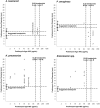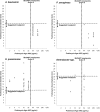Susceptibility of multiresistant gram-negative bacteria to fosfomycin and performance of different susceptibility testing methods
- PMID: 24323469
- PMCID: PMC3957874
- DOI: 10.1128/AAC.02048-13
Susceptibility of multiresistant gram-negative bacteria to fosfomycin and performance of different susceptibility testing methods
Abstract
Fosfomycin may be a treatment option for multiresistant Gram-negative bacteria. This study compared susceptibility methods using 94 multiresistant clinical isolates. With agar dilution (AD), susceptibilities were 81%, 7%, 96%, and 100% (CLSI) and 0%, 0%, 96%, and 30% (EUCAST), respectively, for Acinetobacter baumannii, Pseudomonas aeruginosa, Klebsiella pneumoniae, and Enterobacter spp. Categorical agreement between Etest and AD for Enterobacteriaceae and A. baumannii was ≥80%. Disk diffusion was adequate only for Enterobacter. CLSI criteria for urine may be adequate for systemic infections.
Figures



References
-
- Fritsche TR, Sader HS, Toleman MA, Walsh TR, Jones RN. 2005. Emerging metallo-beta-lactamase-mediated resistances: a summary report from the worldwide SENTRY antimicrobial surveillance program. Clin. Infect. Dis. 41:276–278 - PubMed
MeSH terms
Substances
LinkOut - more resources
Full Text Sources
Other Literature Sources
Medical
Miscellaneous

